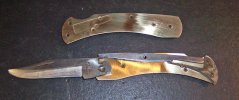- Joined
- Jan 27, 2007
- Messages
- 6,518
I have a 6OT, SCHRADE+, and I just realized how it seems to be below standard in it's material & build quality. Brings up some questions . . .
Here's the story:
I have four Schrade lockbacks - a 7OT, the 6OT, a regular LB7, and an Uncle Henry/SCHRADE+ LB7. These were bought as my hard use (tool box, camping, bug-out kit, etc.) knives.
I bought the 7OT in 1995 or 1996. Typical U.S. Schrade: tight lock up, great fit & finish. When I bought the LB's, both used, they needed some tweaking: really bad grit & crud in the joints, tarnished bolsters, etc. I loosened the joints, sprayed hot water then WD40, and they're great now.
I loosened them this way: take an open LB7, place the spine of the blade in the end of the joint in the other, and gently pry until it loosens a little. When all the cleaning is done, gently squeeze the pivot end in a padded vice until proper tightness is achieved. Worked perfectly for me.
So, here's the deal: I bought the (used) 6OT at an antique shop. It was in pretty bad shape - it had been used as a hammer, scraper, prybar, digging tool . . . you name it, this poor knife has had it done to it. So, I go to gently pry the joint to try and clean it up, and . . . the spine of an LB7 doesn't fit into the joint of my 6OT.
As I looked more closely, I noticed:
- the blade & spring on the 6OT is thinner;
- the bolsters are not finished nearly as well as on the LB7's and the 7OT;
- the handle actually hurts to grip it tight; very hard corners & edges, unless wearing gloves.
- the delrin has no depth . . . meaning the dark color looks 'sprayed' onto the lighter color. It doesn't have that nice old subtle fade from light to dark, that the brown delrin Old Timers usually have.
- even after cleaning, the opening/closing is terribly rough, almost like the bearing area between blade pivot & spring are rough & not finished.
So, what gives? Were the 6OT's of differing dimensions than the LB7's & 7OT's? Not as nicely finished? Different quality delrin? I know the 6OT's are a 'barehead' type of pattern, with no rear bolster, but were they that much different from the others, or did I get a 'second', or late (after bankruptcy) piece?
So, a little long-winded, I know, but I was really surprised to suddenly notice this. Compared to all the U.S Schrades I have, this one has become the 'ugly stepchild' of the bunch.
thx - cpr
Here's the story:
I have four Schrade lockbacks - a 7OT, the 6OT, a regular LB7, and an Uncle Henry/SCHRADE+ LB7. These were bought as my hard use (tool box, camping, bug-out kit, etc.) knives.
I bought the 7OT in 1995 or 1996. Typical U.S. Schrade: tight lock up, great fit & finish. When I bought the LB's, both used, they needed some tweaking: really bad grit & crud in the joints, tarnished bolsters, etc. I loosened the joints, sprayed hot water then WD40, and they're great now.
I loosened them this way: take an open LB7, place the spine of the blade in the end of the joint in the other, and gently pry until it loosens a little. When all the cleaning is done, gently squeeze the pivot end in a padded vice until proper tightness is achieved. Worked perfectly for me.
So, here's the deal: I bought the (used) 6OT at an antique shop. It was in pretty bad shape - it had been used as a hammer, scraper, prybar, digging tool . . . you name it, this poor knife has had it done to it. So, I go to gently pry the joint to try and clean it up, and . . . the spine of an LB7 doesn't fit into the joint of my 6OT.
As I looked more closely, I noticed:
- the blade & spring on the 6OT is thinner;
- the bolsters are not finished nearly as well as on the LB7's and the 7OT;
- the handle actually hurts to grip it tight; very hard corners & edges, unless wearing gloves.
- the delrin has no depth . . . meaning the dark color looks 'sprayed' onto the lighter color. It doesn't have that nice old subtle fade from light to dark, that the brown delrin Old Timers usually have.
- even after cleaning, the opening/closing is terribly rough, almost like the bearing area between blade pivot & spring are rough & not finished.
So, what gives? Were the 6OT's of differing dimensions than the LB7's & 7OT's? Not as nicely finished? Different quality delrin? I know the 6OT's are a 'barehead' type of pattern, with no rear bolster, but were they that much different from the others, or did I get a 'second', or late (after bankruptcy) piece?
So, a little long-winded, I know, but I was really surprised to suddenly notice this. Compared to all the U.S Schrades I have, this one has become the 'ugly stepchild' of the bunch.
thx - cpr






